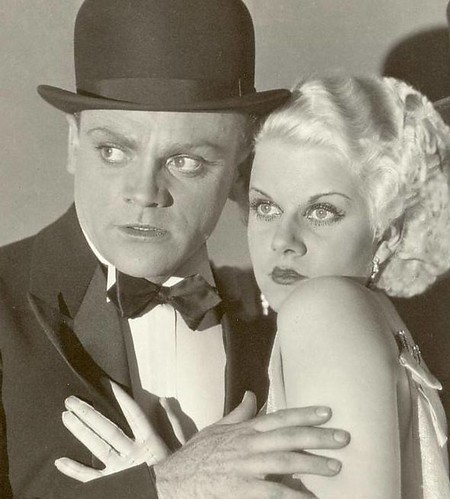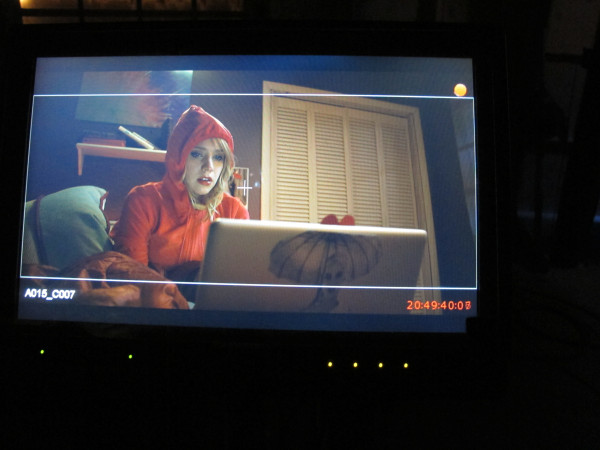 |
| In The Public Enemy with James Cagney |
Long before Betty Grable, Marilyn Monroe, Pamela
Anderson and Scarlett Johannsen, there was a wisecracking dame who brought the
words ‘blonde bombshell’ into the American vocabulary. From 1931 to 1937, Jean
Harlow ruled the silver screen, combining seductive looks with comedic talent
to become one of cinema’s funniest sex symbols. With her signature wit, Harlow
broke the Hollywood mold by becoming the ultimate screen siren without
sacrificing any substance. Behind Harlow’s sassy smile, however, lay a
complicated life filled with trials, tribulations, and tragedy.
Jean Harlow was born Harlean (an anagram of her
mother’s maiden name) Carpenter in Kansas City Missouri on March 3, 1911. Contrary
to the rough and tough image that she often portrayed on screen, Harlow was actually
born to a well-off family; her father, Mont Clair Carpenter, ran a successful
dental practice and her mother, Jean, was the daughter of wealthy real estate broker
Skip Harlow. Skip had reportedly arranged the marriage against Jean’s will,
leading her to resent her husband and rely upon her daughter for comfort in her
empty marriage. As a result, young Harlean grew up with an extremely close
relationship with her mother that bordered on codependency. When Harlean was eleven years old her
parents finally divorced, which resulted in Jean winning full custody and Mont
Clair disappearing from their lives.
Mother and daughter moved to Los Angeles in an
attempt to begin the acting career that Jean had always dreamed of, but had
been forced to put aside when she married. Unfortunately, Jean’s age (she was
thirty-four upon her arrival) proved to be too much of a career handicap, and
the pair was forced to return to Kansas City the following year. While Harlean
did attend the Hollywood School For Girls where she met Hollywood royalty and future
stars such as Douglas Fairbanks Jr., Joel McCrea, and Irene Mayer Selznick, she
did not share her mother’s interest in show-business, and considered her acting
career over before it began. By 1926, Jean began seeing Chicago native Marino
Bello and enrolled Harlean in the Ferry Hall School near Chicago. It was at
Ferry Hall that Harlean met and began a relationship with her first husband,
Charles McGrew. In 1927, at age sixteen, she married the wealthy McGrew and the
two moved to Beverly Hills where they lived a life of leisure in high society.
It was during her time as a Beverly Hills socialite that Harlean was given the
opportunity to become the actress that her mother, Jean, had always wanted to
be. While waiting for an actress friend she was picking up at the studio, she
was approached by a Central Casting agent at Fox Studios and asked to audition.
Although she had never given acting serious consideration, she agreed to attend
the audition after being pressured by both her friend and her mother. The
audition was a success and she began working as an extra at Fox Studios and Hal
Roach Studios under the name Jean Harlow, despite the strain that her career
put on her marriage. McGrew was already a heavy drinker when Harlow auditioned,
and the tension caused by her mild success led him to rely even more upon
drinking. The marriage finally reached its breaking point in 1929 when the
couple divorced and Harlow moved in with her mother and stepfather, (Jean and
Bello had married in 1927) who had recently moved to Los Angeles.
Harlow received her first major role in 1930 in
Howard Hughes’ World War I aviation epic, Hell’s Angels. In the notoriously
risqué film, Harlow debuted her newly dyed platinum blonde hair and the
infamous line “Would it shock you if I were to put on something more
comfortable”. Although critics panned her performance, audiences couldn’t get
enough of the snappy blonde and she quickly developed a devoted following. Her
famous hair color proved to be just as popular as her acting, prompting fans across
the country to dye their locks despite the damage that early hair bleaches
often inflicted. She followed-up the next year with the gangster classic The Public Enemy, bringing a touch of class
to the role of James Cagney’s moll that had been previously turned down
by silent star Louise Brooks. She went on to appear in a series of films that
capitalized on her newfound fame as a screen vamp, but quickly grew tired of
the brash persona that the studio had labeled her with, saying “must I always
wear a low-cut dress to be important?”. She also seemed to find success in her
personal life by marrying MGM executive Paul Bern in 1932, and attaining a
contract at MGM with his help. This early success was quickly shaken, however,
when Bern was found dead of a gunshot wound in the couple’s home during the
shooting of Red Dust . Although Bern’s death was officially ruled a
suicide, speculation abounded that Harlow may have been involved. MGM had
already been attempting to alter her sexy persona to conform to the studio’s
glossy but wholesome image, and doubled its efforts after the scandal
surrounding Bern’s death. Harlow shocked the studio when she maintained her
production schedule and not only survived the scandal, but thrived as one of
America’s favorite screen comediennes.

Despite her
screen success, Harlow found herself in professional hot water again after she
was involved in yet another personal scandal. Following Bern’s death, Harlow
had begun an affair with married boxer Max Baer and was cited in Baer’s divorce
proceedings, despite the fact that he had been legally separated from his wife
when they began their relationship. In order to prevent a possible backlash,
MGM arranged for Harlow to marry her friend, cinematographer Harold Rosson in
1933; the two amicably divorced once the story had ceased to be of public
interest one year later. Over the course of the next three years, Harlow went
on to star in a series of diverse films ranging from melodramas to slapstick
comedies and became the fourth highest grossing actress at the box office. In
an interesting twist of fate, one of her most notable roles, actress Lola Burns
in Bombshell, was actually based in
part off of her personal experiences supporting her mother and stepfather as a
cinema sex symbol (combined with facts from the life of 20’s star Clara Bow). She
was finally able to rise above typecasting when the advent of the Hay's Code in
1934 prevented studios from writing the racy parts that she had previously been
relegated to. While the restrictions of the code hampered the careers of many
30’s stars, those same restrictions actually provided Harlow with the artistic
freedom that she had been craving, and enabled her to improve upon and test her
range as an actress. The films she made during these years prove that she was
far more than a mere pretty face with a striking hairstyle and was actually a
gifted comedic actress.
Throughout her career, Harlow was known for being pleasant
to work with and well-liked by her costars. She became close friends with
frequent co-star Clark Gable, who was known to look out for her much in the
same way he would a younger sister and even nicknamed her ‘Sis’. She also formed lasting friendships with
actresses Myrna Loy, Rosalind Russell, and Carole Lombard. In 1934, she began a
relationship with fellow MGM star William Powell and the couple reportedly
became engaged. Despite their seemingly happy romance, the two were prevented
from marrying by pressure from studio head Louis B. Meyer and their inability
to agree on whether or not to have children (she wanted children but Powell
didn’t). By 1936, Harlow began complaining about health concerns such as weight
gain, sunburns, fatigue, nausea, and abdominal pain, but her doctors concluded that
she was simply feeling the after effects of a particularly serious bout of
influenza. By 1937, her health began to seriously decline, as her body swelled
to twice its normal size and she became so fatigued that she was barely able to
maintain her work schedule. After being in and out of hospital care for several
months, Harlow entered a coma while shooting her final film, Saratoga, and was admitted to Good
Samaritan Hospital where she was diagnosed with kidney failure. It is now
believed that the dye she used to obtain her infamous hair color may have
contributed to her illness, as its mixture of bleach and ammonia combined
to create hydrochloric acid, a chemical that is poisonous after chronic
exposure. Harlow was pronounced dead on June 7, 1937 at age twenty-six.; even
if she had been diagnosed earlier, the limited medical treatments of the 1930’s
would not have been able to treat her condition.
In her twenty-six years, Jean Harlow lived through
more triumphs and tragedies than many people do in a century. She was a woman
who lived life according to her own rules and to the fullest of her ability.
She was also a multifaceted artist who left behind twenty one starring films
ranging from drama to slapstick, as well as a posthumously published novel. Her
image went on to inspire generations of fans including a young Marilyn Monroe,
who reportedly referred to Harlow as her “idol” and comic artist Bob Kane who
cited her (along with actress Hedy Lamarr) as the inspiration behind his iconic
anti-heroine Catwoman. Harlow once said, “I’m not a born actress. No one knows
that better than I”, whether she was born with her talent or cultivated it, there
is no denying that she was an endlessly fascinating actress without whom cinema
would be much less entertaining.
 |
| In Red Dust with Clark Gable |



























